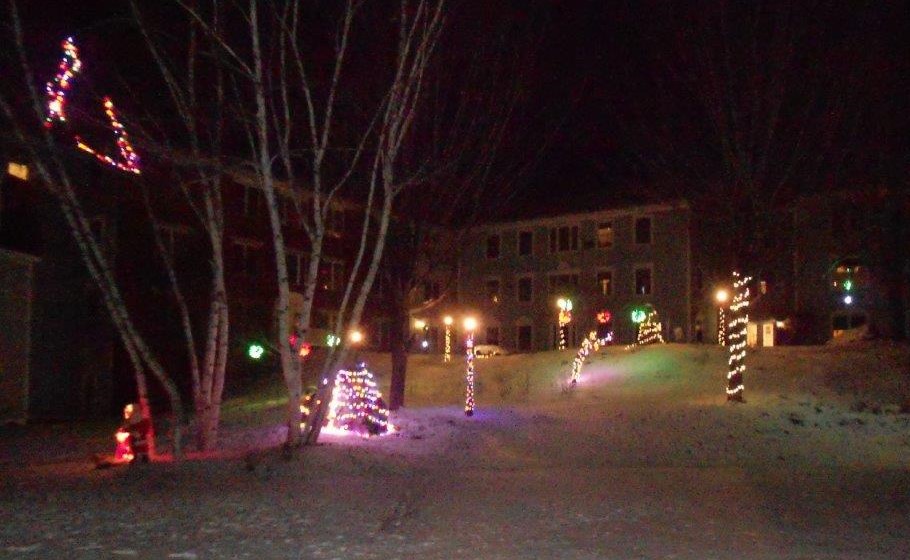Archive for December 2020
Keeping patients safe for eye exams
By Nathan Tsukroff
LEWISTON – Seeing patients means careful screening and social distancing for medical practices under COVID-19 restrictions.
That’s especially true at Optometric Associates on East Avenue in Lewiston.
From the initial screening of all patients and visitors to the practice, through examinations and checkout, doctors and other staff at the practice have created a safe environment for anyone needing help with issues with their eyes.
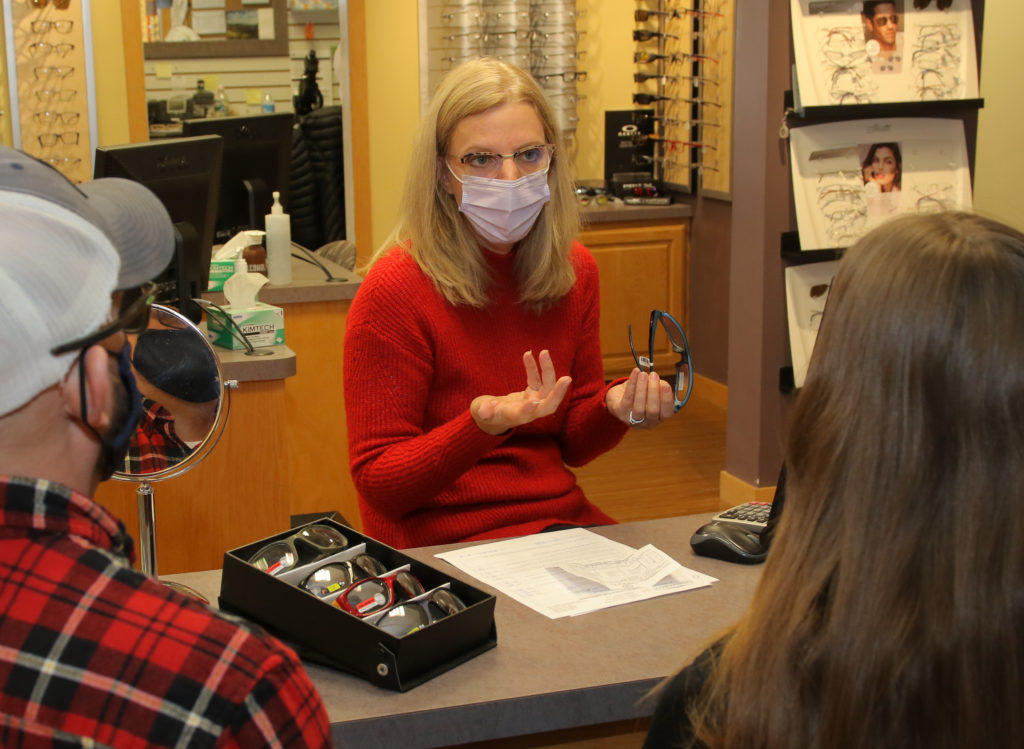
Optometric Associates is a team of three doctors who treat issues ranging from patients needing glasses to those suffering from glaucoma, problems with the retina (the rear of the eye, where images are formed), dry eye, or needing LASIK comanagement.
Practice management was made all the more difficult with the restrictions imposed under the State of Maine COVID-19 guidelines. Like other businesses in Maine, the practice closed its doors near the end of the March as the state was temporarily shut down at the start of the pandemic.
“During that time I consulted a lot of the guidelines from the (Maine Center for Disease Control) CDC on how to maintain as safe as possible conditions to continue to do eye exams,” Douglas J. Henry, O.D., Ph.D., said.
Henry is the lead doctor for the practice, having joined Drs. George Bournakel and Pauline Beale at the practice in 1999. Both doctors have since retired.
Dr. Stephen Ebersole joined the practice about 14 years ago, and Dr. Abigail Heroth just came on board in August.
Under the pandemic guidelines, “We screen everyone with questions, as well as the temperature screen before they enter. We also do a lot more cleaning. We’re cleaning the rooms thoroughly – cleaning everything the patient touches when they visit. Even the pens they use to sign in are immediately put in a bin to be sterilized.”
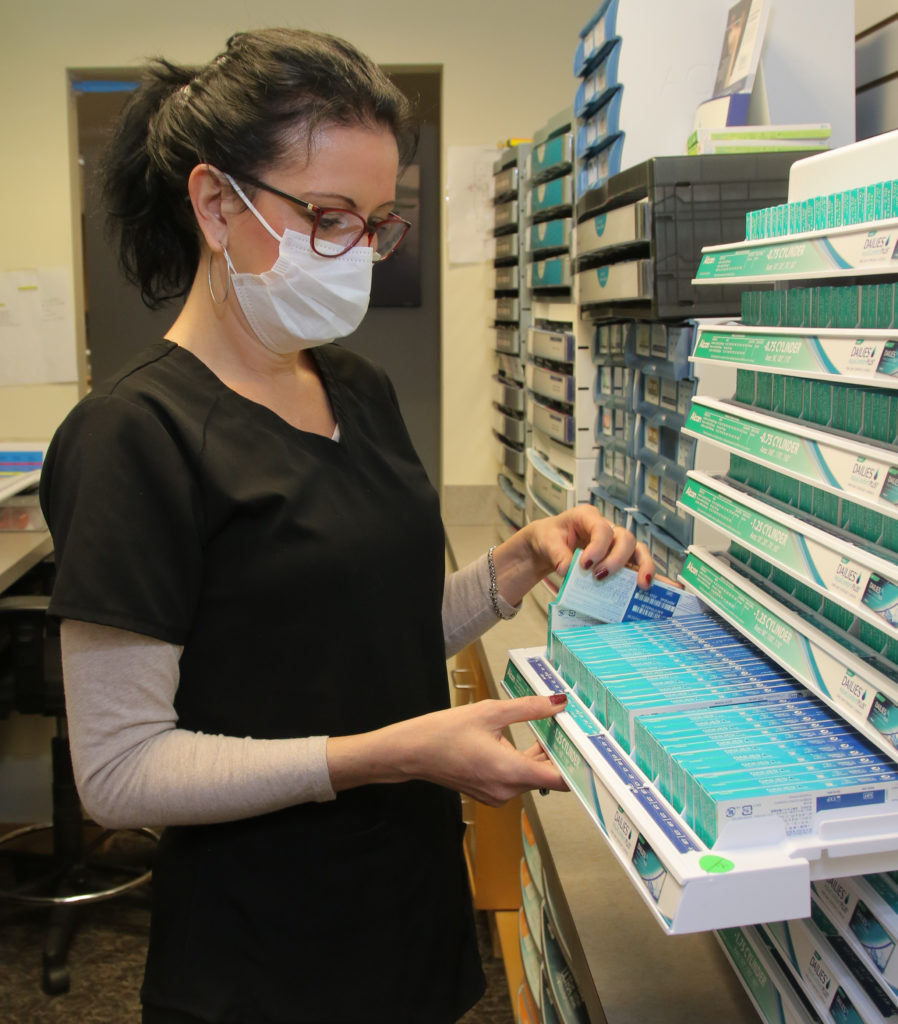
The practice has an optical center where patients can purchase glasses, and “When someone tries on glasses, they’re kept aside and then they’re sterilized before they’re put out again,” Henry said. Everything a patient touches during a visit is wiped down with sterilizer.
“My staff is seeing about the same number of patients a day as we did before (the COVID-19 restrictions), but they’re working a lot harder,” he said. Staff members at the practice guide patients on social distancing needs, as well as sterilizing items and rooms throughout the day.
Even in the optical center, which is an open area at the front of the practice, “We’ve maintained social distancing. There’s only so many visitors allowed at a time,” Henry said. And there is “lots of wiping down everything.”
Many of the patients at the practice are older, he said, so these precautions are important for their safety, along with the safety of staff members. “We have staff that are in high-risk groups, that are older, that have physical conditions.”
“It’s even tougher for our employees that are parents, because now they’ve got to deal with possible exposures at their children’s school, and they’ve got to worry about bringing that into the office,” Henry said. “So there’s a lot of guidelines to follow!”
Remote schooling means some staff members with children have not been able to work the same hours as in the past, which adds another layer of complexity to running the practice during the pandemic. Because a staff member might need to stay home, “We don’t always have a full staff,” Henry said. Some parents have had to quarantine with a child who was exposed to a classmate diagnosed with COVID-19.
“We’ve been trying to make work hours more flexible when we can. but we’ve had to deal with a lot of short-staffing issues, like a lot of other businesses, too, especially the healthcare,” he said. That’s another reason staff members “have been working harder, too – to cover for each other.”
The practice was shut down completely for about seven weeks in the spring, then opened back up “at a trickle,” with only five people at a time visiting the building the first month, Henry said. That was a difficult requirement to meet at times, since patients sometimes needed to bring a family member.
“I’m very proud of my staff, and I’m proud to say that patients have sometimes said this is the first public place they’ve been to since self-quarantining, and that they felt safe,” He said. “Or, they’ve said this the first place they’ve actually felt safe in public, because we’re being so careful.”
Patients arriving at the practice can come to the entrance of the building where they are greeted by a staff member and invited into the vestibule for screening. A touchless thermometer is used to read forehead temperatures, and patients are asked about their personal health and any exposure to someone with COVID-19, before being allowed to enter the practice.
The practice has been here in Lewiston about 65 years beginning in the mid-1950’s under Dr. Sam Alpern. Dr. Bournakel joined as an associate of Dr. Alpern, then brought in Dr. Beale about 46 years ago.
The practice built and moved into its current quarters in the mid-1970’s.
Dr. Henry began practicing with an emphasis on contact lenses, glaucoma, ocular disease, and primary care. He is a Phi Beta Kappa graduate of the University of Illinois and earned his Ph.D. in Neurobiology at Wayne State University in Detroit, Michigan. As a neuroscientist, he authored 15 research articles and book chapters, and earned several teaching awards.
Dr. Ebersole graduated from the University of Delaware with a bachelor of arts degree in biology, then earned his doctorate of optometry at Ohio State University. He went on to complete a residency program centered on the diagnosis and management of common ocular diseases. such as glaucoma, cataracts, and macular degeneration. He served on the Maine Optometric Associations Board of Directors where he was instrumental in bringing the InfantSEE® program to Maine. The InfantSEE® program is a public health program developed to provide professional eye care for infants nationwide.
Dr. Heroth, earned her doctorate of optometry from the Pennsylvania College of Optometry, graduating with honors in the spring of 2019. She spent the next year in a post-doctoral residency focused on ocular disease and primary care while working in the Togus VA Medical center in both Augusta and Bangor.. She had previously earned a bachelor of arts in Biotechnology and Molecular Biology at Assumption College in Worcerster, MA.
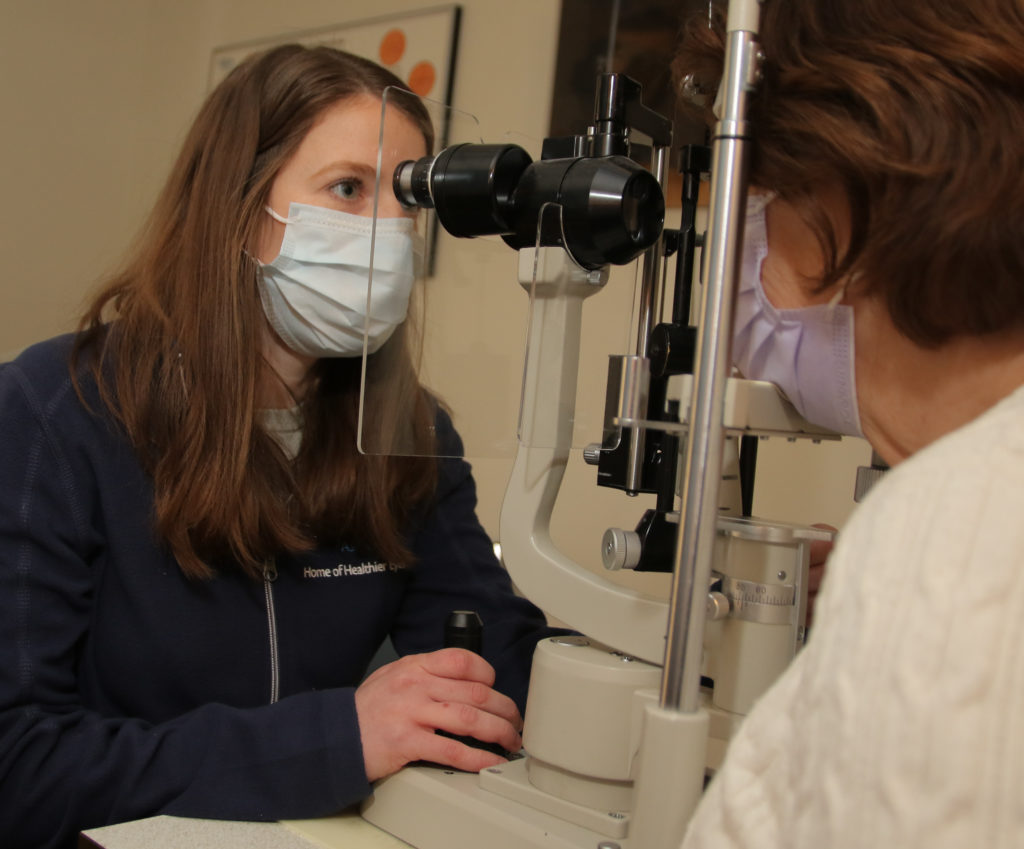
Dr. Henry sees the practice expanding in the future with the need for eye care in the central Maine area, although he said that “times are uncertain these days” and adding additional doctors will be balanced against the flow of patients allowed under pandemic restrictions.
Optometric Associates provides a unique service for patients with dry eye, a chronic condition in which the body does not produce enough tears, or poor quality tears that don’t sufficiently lubricate the eye.
In addition to providing traditional treatments for dry eye – such as eye drops, prescription medicines, and At-home treatments like a Bruder mask, or lid therapies like Hypochlor and Avenova – the practice provides a treatment called Lipiflow. This treatment provides precise thermal pulsation to the meibomian tear glands to enhance tear quality and ocular discomfort. It combines heat with physical massage to liquefy and express the meibomian gland contents in an effort to return the lipid layer of the ocular surface to normal condition.
The three doctors at the practice are optometrists, eye doctors that can examine, diagnose, and treat eyes. If a patient needs surgery, they will be referred to an ophthalmologist, who is a medical doctor that performs perform medical and surgical interventions for eye conditions.
The practice also has a staff of opticians, who are professionals that help fit eyeglasses, contact lenses, and other vision-correcting devices.
Door to door holiday celebration
Out and About
By Rachel Morin
The Tenants of Schooner Estates Senior Living Community in Auburn were treated to a traveling Door to Door Holiday Celebration this past week.
Schooner Estates, as always, hits a problem head on and comes up with a solution. The worldwide Pandemic was no different. Schooner found a way, safe and practical.
(Something had to replace the large Christmas Party gatherings for all tenants in the Tenants’ Harbor Room in past years!)
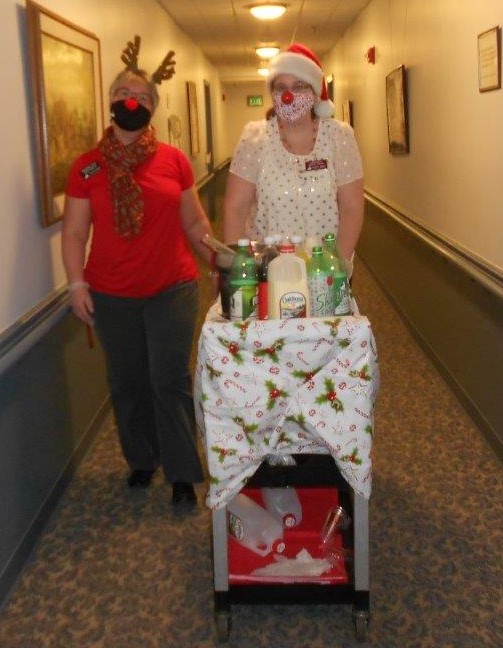
The traveling Door to Door Holiday Celebration took off like a flash. All hands were on deck at Schooner to send wave after wave of deliciously prepared holiday appetizers, food, delicacies and drinks to the apartment door of every tenant in his or her home.
Staff, decked out in holiday attire, pushed lighted carts laden with jumbo shrimp, cocktail sauce, savory sauced meatballs, scallops wrapped in maple bacon, lobster salad, Brioche bread, specialty chicken salad sliders, prosciutto and gruyere grilled triangled finger sandwiches, along with eggnog mixed with holiday cheer and a wide assortment of desserts and petit fours, to every apartment door at Schooner Estates.
All the Center for Disease Control protocols and guidelines for Covid-19 virus and recommendations were in place.
Tenants wearing masks were ready at their open doors to greet the staff, also wearing masks and gloves, who requested the tenant point to a selection they wanted.
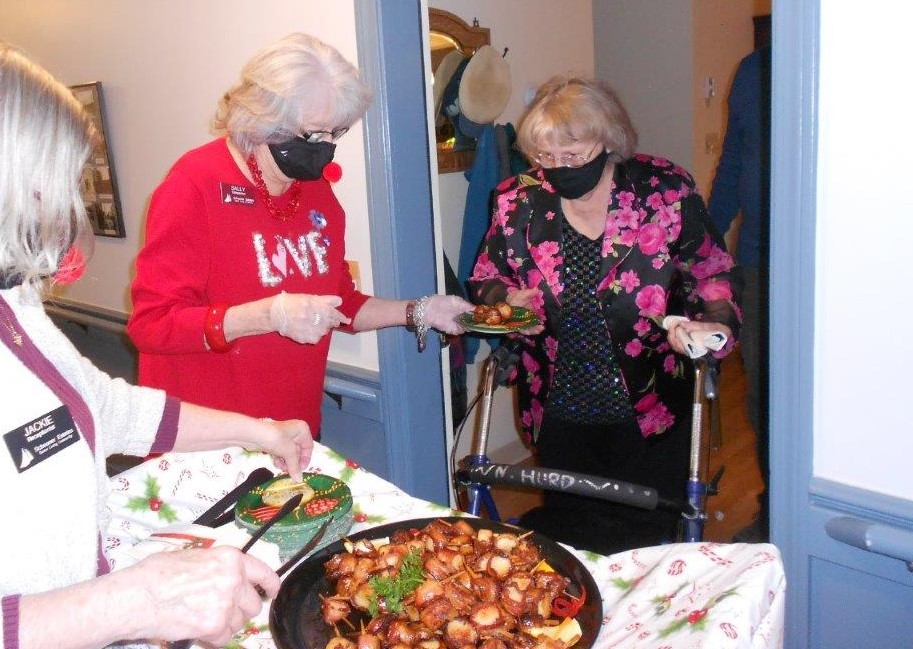
The server placed the item on a holiday plate, with holiday napkin, and handed it to the tenant who brought it into his/her apartment.
After the assortment of different foods were served came the dessert menu, and then the drinks selections. This procedure was done, time after time, on all floors. in all buildings. Elevators were busy and everything was done in record time.
With the transmission of the COVID-19 virus so prevalent across the U.S. and in Maine, the Staff took extra caution to minimize the time spent at each apartment door and not linger for conversation.
Every apartment was tuned in to Schooner’s own channel 1390 for a beautiful screen filled with a roaring fire in the fireplace. Traditional Christmas music could be heard throughout the buildings. Jolly old Saint Nicholas himself made the rounds to every apartment to drop off the annual Christmas gifts.
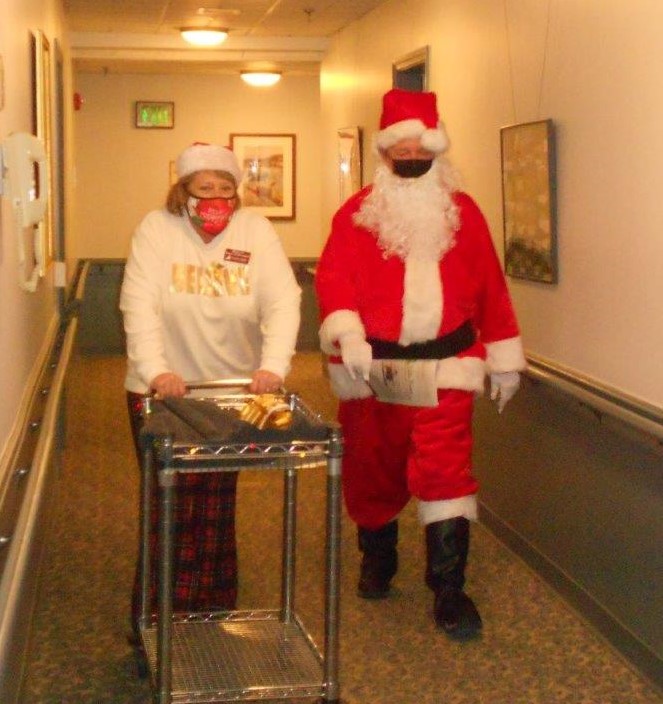
The Door to Door Holiday Celebration was well received by all. The evening ended merrily. Tenants could be overheard on the telephones with their families giving them a happy play by play of what was happening.
Who knows, this may very well be the new Christmas Tradition!
Virtual “Lighting Up Lewiston”
From City of Lewiston
LEWISTON – The City of Lewiston and the Lewiston Lighting Committee have launched the virtual celebration ceremony, “Lighting Up Lewiston.”
The lighting project began as a grassroots effort by local business owners who were interested in increasing holiday lighting in Lewiston. Through their diligent work, the Lewiston Lighting Committee was established to continue these efforts in partnership with City of Lewiston staff and the Downtown Lewiston Association.
For 2020, donations to purchase and install globes were made in recognition of an anniversary, in tribute to someone; in memoriam, or for the love of community. Each year going forward, a designated area of Lewiston is envisioned to come alive with new multi-size globes and other lighting, creating an enhanced and growing festive presence.
Thanks to community generosity in 2020, a total of 53 globes were placed in Dufresne Plaza, Lisbon Street, as well as increased lighting added to the Southern Gateway entrance into Lewiston, adding even more warmth and vibrancy to the downtown area.
The virtual ceremony with various announcements and video contributions can be viewed at: https://ytube.io/3Cno
A particularly informative aspect of the virtual celebration is a piece from Carmen Dufresne. In 2012, the plaza was named after her father, Chief Justice Armand A. Dufresne, and she provides a very insightful oral history of her parents’ lives in Lewiston.
To visit the tribute page for this project, which includes the names of those being celebrated and by whom, please visit https://bityl.co/4yej
The City of Lewiston thanked Lewiston Public Works crews who were instrumental in installing the globes.
Christmas Kitten Commercial turns 40
From BSB
BANGOR – If you grew up in Maine, the iconic Bangor Savings Bank commercial featuring two playful kittens is a beloved part of your holiday memories.
Waylon and Willie scurry under the Christmas tree, swat their paws at ornaments, tear open gift-wrapping paper, and lap up the milk they spilt – all while a musical medley plays that has become embedded in our collective consciousness.
While every advertisement has a shelf life, the Christmas Kittens are truly the exception, standing the test of time with an annual airing every holiday season since its debut in 1980. For many, the Christmas season didn’t begin until this 60-second image ad – meant to evoke an emotion rather than sell a product – had hit the airwaves. Forty years later, it’s still going strong with some fans asking as early as August: When will the kittens ad begin playing?
To mark the commercial’s 40th anniversary, Bangor Savings Bank released a video that talks about the history of the ad, and is making a major donation to local animal shelters.
The video at www.bangor.com/kittens peeks behind the curtain of one of the most iconic TV ads the region has ever seen.
Featured in the video are Phil Cormier, a TV commercial editor who worked on the ad; The Nite Show’s Danny Cashman, who parodied the commercial; and comments about the ad from Bangor Savings Bank employees.
The ad includes trivia, such as the names of the kittens (Waylon and Willie), that it took four times as long to shoot the commercial because Waylon and Willie kept falling asleep, and that the “meow” at the commercial’s end didn’t come from a cat – but from a studio employee
Bangor Savings Bank is donating $10,000 to animal shelters in Maine and New Hampshire. The shelters will be chosen by an online vote that runs until midnight, Dec. 31. Voters can submit their choice at the video website at www.bangor.com/kittens
Auburn Reverse Parade of Lights
From City of Auburn
AUBURN – Instead of the traditional Twin Cities Parade for the Christmas Holiday, Auburn hosted a “Reverse Parade of Lights” this year.
Families and businesses decorated their homes and buildings to celebrate the season.
The City of Auburn published a map on its Home for the Holidays website page at http://bitly.ws/aQSo and invited everyone to drive by and view the decorations.
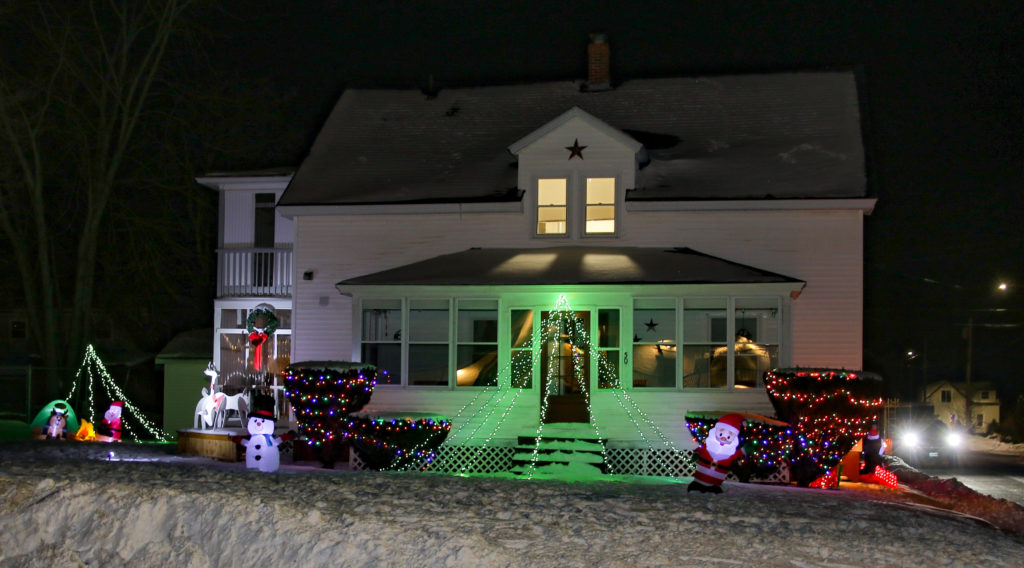
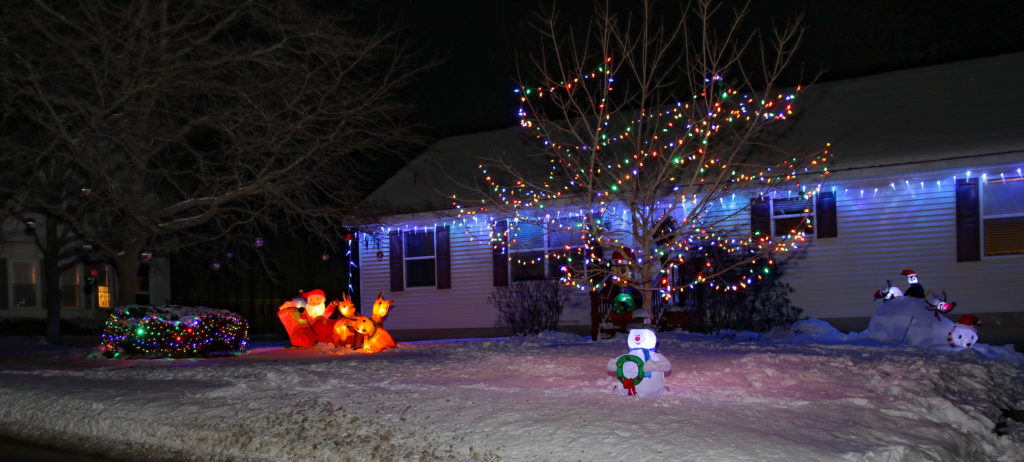
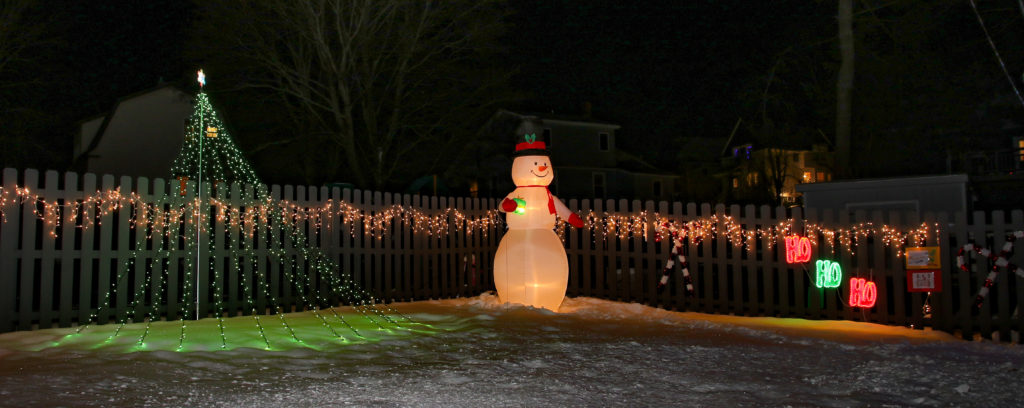
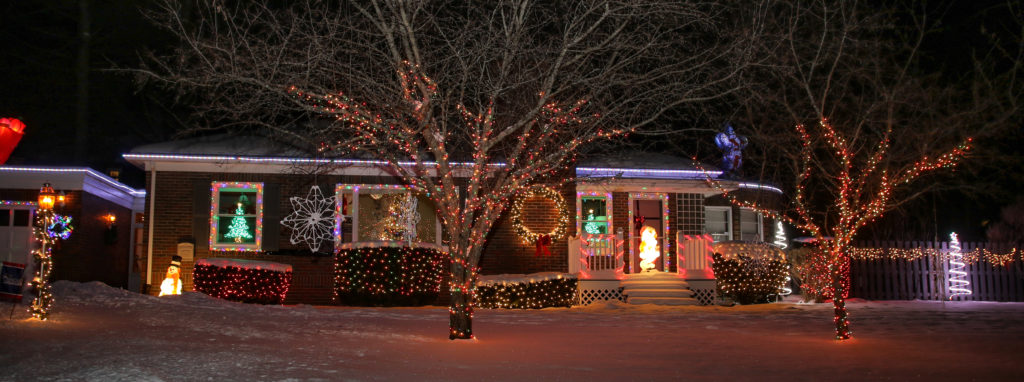
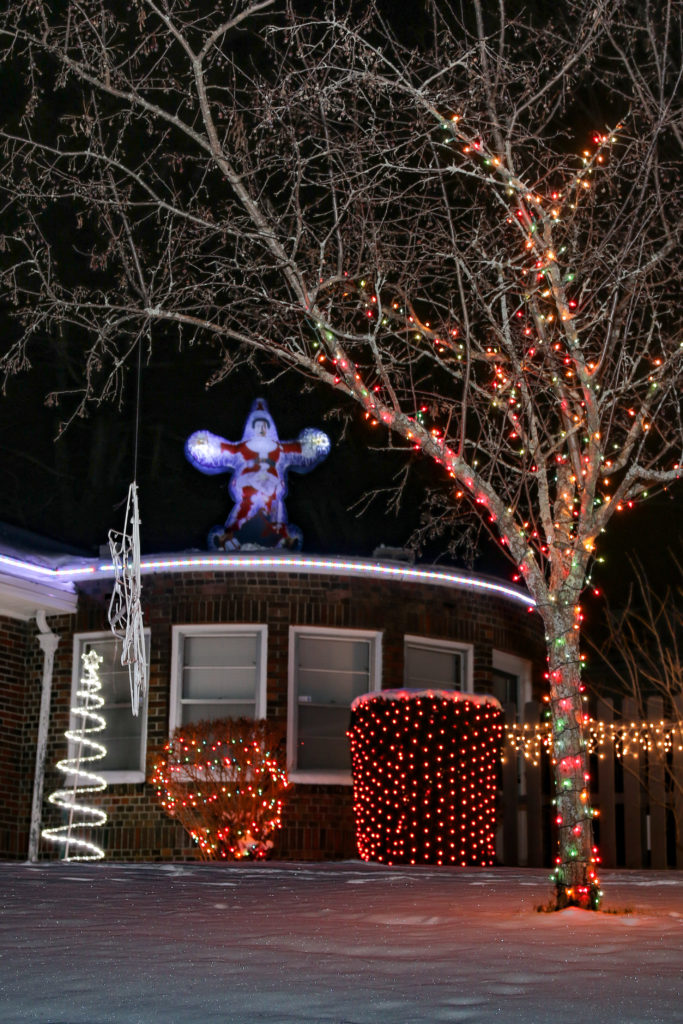
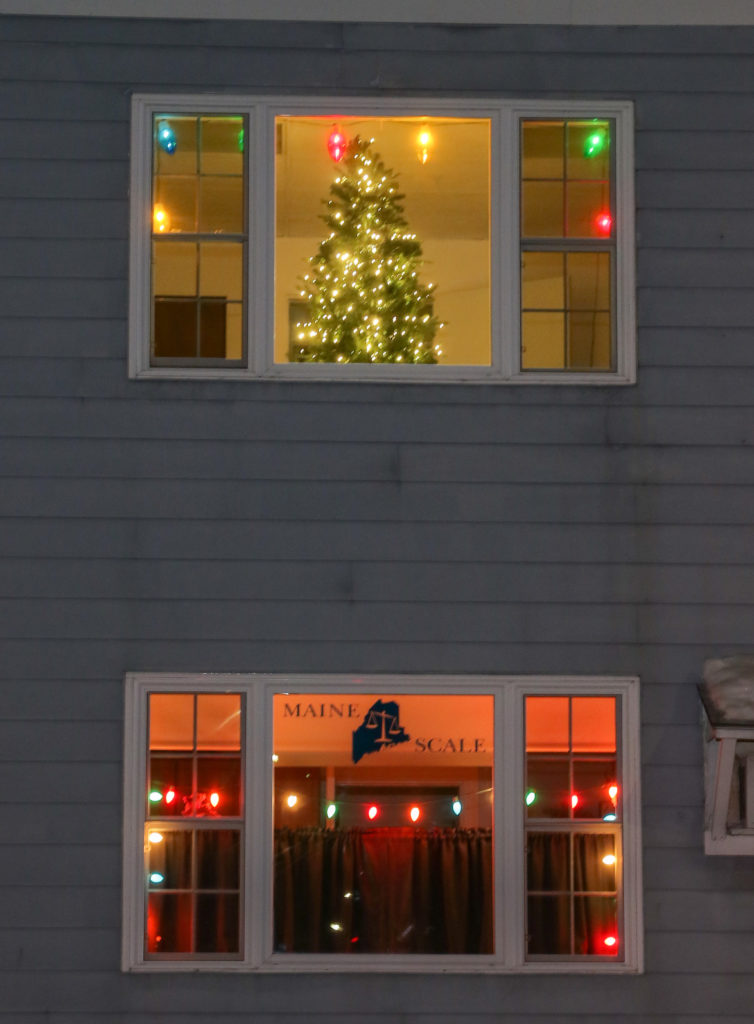
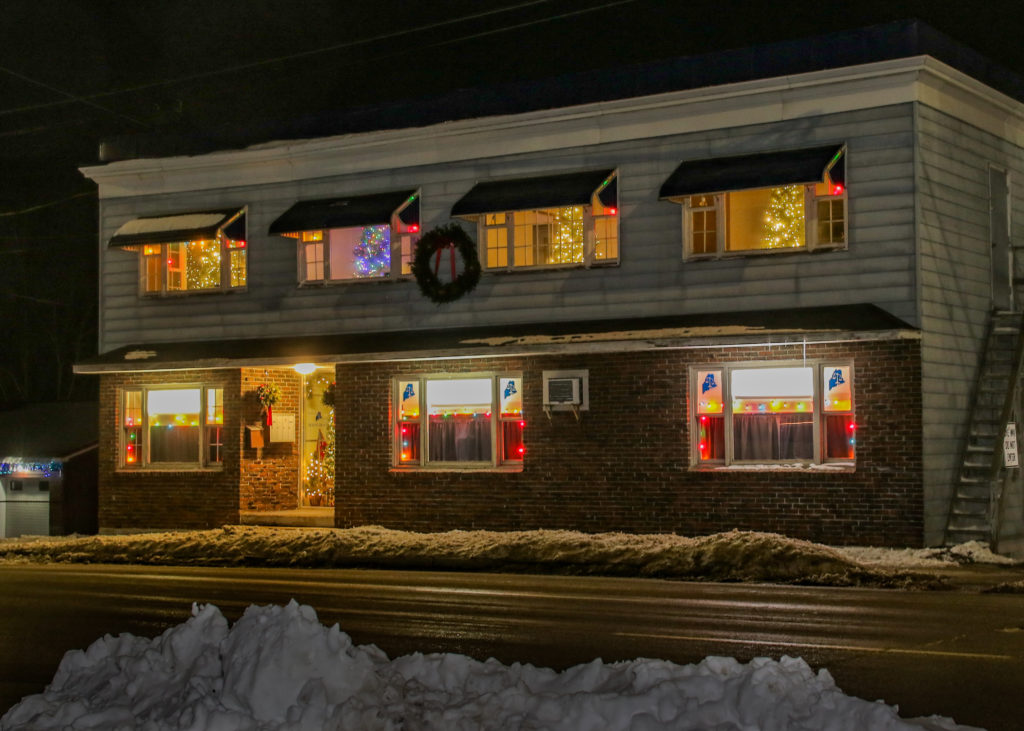
Cumberland County designated ‘yellow’
From Maine DOE
AUGUSTA – The Maine Department of Education announced last week that the Mills Administration designated Cumberland County as “yellow” due to increased case rates and positivity rates.
This was done in the weekly update to the administration’s color-coded Health Advisory System that classifies counties’ relative risk of COVID-19 transmission to assist schools as they continue with their plans to deliver instruction and support to students safely.
The Maine Department of Health and Human Services (DHHS) and Maine Center for Disease Control and Prevention (Maine CDC) continue to review evidence that indicates lower transmission of COVID-19 in schools compared to the general population. Over the last 30 days, the rate of new cases is 25.2 per 100,000 staff and students, compared to 62.5 per 100,000 people statewide. This lower rate of new cases in schools is consistent with previous weeks.
DHHS and Maine CDC assessed COVID-19 data and trends for all counties. Based on this assessment, the following designations have been determined:
REMAIN YELLOW: Androscoggin, Oxford and York counties have rising positivity rates, exceeding the statewide average.
NOW YELLOW: Cumberland County experienced an increase in both the new case rate per 10,000 people and positivity rate.
All other counties remain in the green designation.
Under the “yellow” designation, which indicates an increased (moderate) level of community risk, schools may consider additional precautions, such as limiting numbers of people in school buildings at the same time, suspending extracurricular or co-curricular activities including competitions between schools, limiting interaction through cohorting, or other measures based on the unique needs of each school community.
These designations are made out of an abundance of caution and for the consideration of school administrative units in their decisions to deliver instruction.
It is essential that school districts across the State of Maine continue to implement plans that adhere to the six requirements for returning to in-person instruction, regardless of their county’s designation.
The Health Advisory System categorizations are defined as follows:
RED: Categorization as “red” suggests that the county has a high risk of COVID-19 spread and that in-person instruction?is not advisable.
YELLOW: Categorization as “yellow” suggests that that the county has an elevated risk of COVID-19 spread and that schools may consider additional precautions and/or hybrid instructional models to reduce the number of people in schools and classrooms at any one time.
GREEN: Categorization as “green” suggests that the county has a relatively low risk of COVID-19 spread and that schools may consider in-person instruction, as long as they are able to implement the required health and safety measures. Schools in a “green” county may need to use hybrid instruction models if there is insufficient capacity or other factors (facilities, staffing, geography/transportation, etc.) that may prevent full implementation of the health and safety requirements.
The county-level assessments are based on both quantitative and qualitative data, including but not limited to recent case rates, positivity rates, and syndromic data (e.g., symptoms of influenza or COVID-19). Those data are publicly posted every week on the Maine CDC website. DHHS and Maine CDC also consider qualitative factors, such as the presence of outbreaks that may potentially affect school-age children.
Wreaths Across America places 1.7 million veterans’ wreaths
From WAA
COLUMBIA FALLS, Maine – Last Saturday, on National Wreaths Across America Day at 2,557 participating locations, dedicated Americans in every state honored our nation’s heroes by safely placing a total of 1.7 million veterans’ wreaths on their headstones and remembering them, by saying each name out loud.
“The 2020 theme for Wreaths Across America has been ‘Be an American worth fighting for,’ and this year I have been blessed to see my fair share,” said Karen Worcester, executive director of Wreaths Across America. “The determination of the American people and their commitment to the mission to Remember, Honor, Teach, made it possible for us to move forward this year, safely. We are humbled, and forever grateful for the outpouring of support from all across the country.”
Wreaths Across America would like to thank the dedicated volunteers in every state for overcoming the many obstacles presented and remaining focused on the mission over the last year. From the individual Location Coordinators working with local officials on modified wreath placement plans, to the professional truck drivers who have been keeping this country moving but found time to help deliver these truckloads of respect, each person has played an important a part in the mission to Remember the fallen, Honor those that serve and their families, and Teach the next generation the value of freedom.
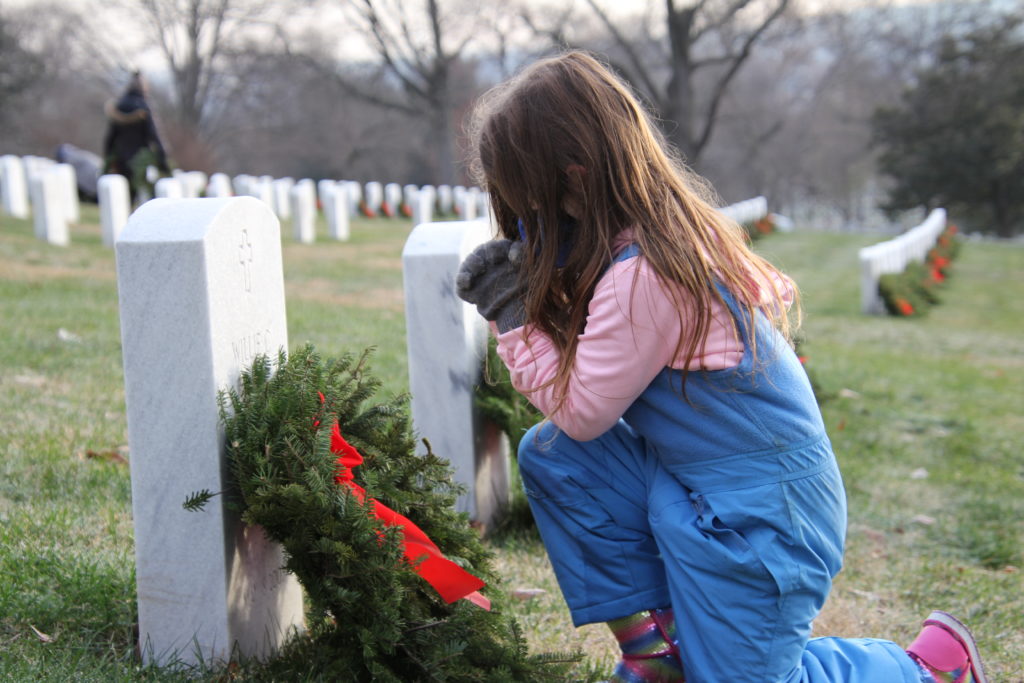
(Photo courtesy of WAA)
Each live, balsam veteran’s wreath is a gift of respect and appreciation, donated by a private citizen or organization and it is placed on graves by volunteers as a small gesture of gratitude for the freedoms Americans enjoy. For centuries, fresh evergreens have been used as a symbol of honor and have served as a living tribute renewed annually.
Wreaths Across America believes the tradition represents a living memorial that honors veterans, active duty military and their families and when volunteers say the name of a veteran out loud, when placing a wreath, it ensures they live on in our memory.
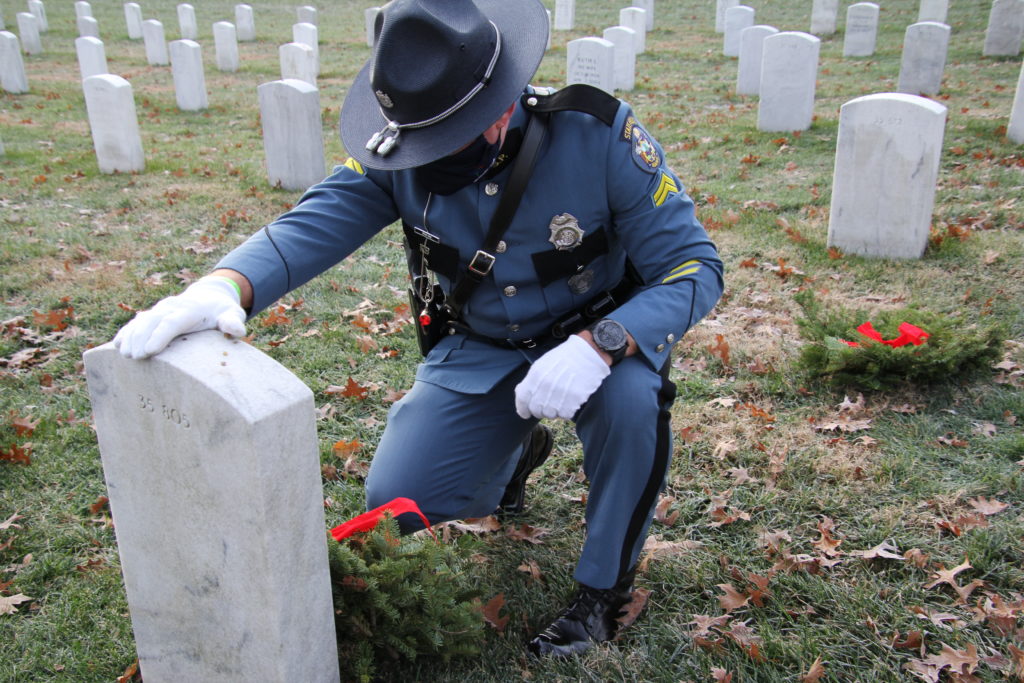
(Photo courtesy of WAA)
For more information, visit www.wreathsacrossamerica.org.
Wreaths Across America is a 501(c)(3) nonprofit organization founded to continue and expand the annual wreath-laying ceremony at Arlington National Cemetery begun by Maine businessman Morrill Worcester in 1992. The organization’s mission – Remember, Honor, Teach – is carried out in part each year by coordinating wreath-laying ceremonies in December at Arlington, as well as at thousands of veterans’ cemeteries and other locations in all 50 states and beyond.
Auburn holiday meal
From City of Auburn
AUBURN – Auburn’s Age-Friendly Community Committee, together with the Auburn Recreation Department and Auburn resident Matt Leonard invite Auburn residents to enjoy a “Special Christmas and New Year’s Meal.”
The free, delicious meal – which will be comprised of three finger rolls (chicken, egg, or ham), chips, a Bismarck pastry, and a water – will be take place from noon-3 p.m. on Wednesday Dec. 30 and will be a “pick-up” only event.
Pre-order is required no later than Dec. 28 and can be done by contacting Jamie Longley at Auburn Recreation at 333-6601 x 2108 or JLongley@auburnmaine.gov.
The meal is free, although donations of any size are welcome.
Teaching “Peaceful Way” makes dojo the Best of Best
Phoenix Academy earns title for third year in a row
By Nathan Tsukroff
AUBURN – For the third year in a row, Phoenix Academy of Martial Arts has been voted Best of the Best for providing the Best Martial Arts Instruction in the Lewiston-Auburn area.
The voting was conducted online by Marketing Surveys of America from Dover, NH, and Phoenix Academy received a substantially higher vote count than last year, said Donna Harris, who owns the school with her husband, Harry. She believes this strong rating is a result of the school’s approach to teaching karate as a way of life, not just a sport.
The school, referred to as a “dojo” – a place for immersive learning or meditation – is located on Center Street in Auburn, and teaches a style of karate called Pinan-Do, which translates to Peaceful Way.
Donna Harris said this style was created by a group of karate practitioners in 2009 who agreed that they felt the need to return to a style of martial arts that goes back to the original roots of karate. Members of the group included the Harrises along with Tony Bennett, Mark Fryover, Randy Martin, and Bill Parquette. They are referred to as “Sosai”, which roughly translates to “founder”.
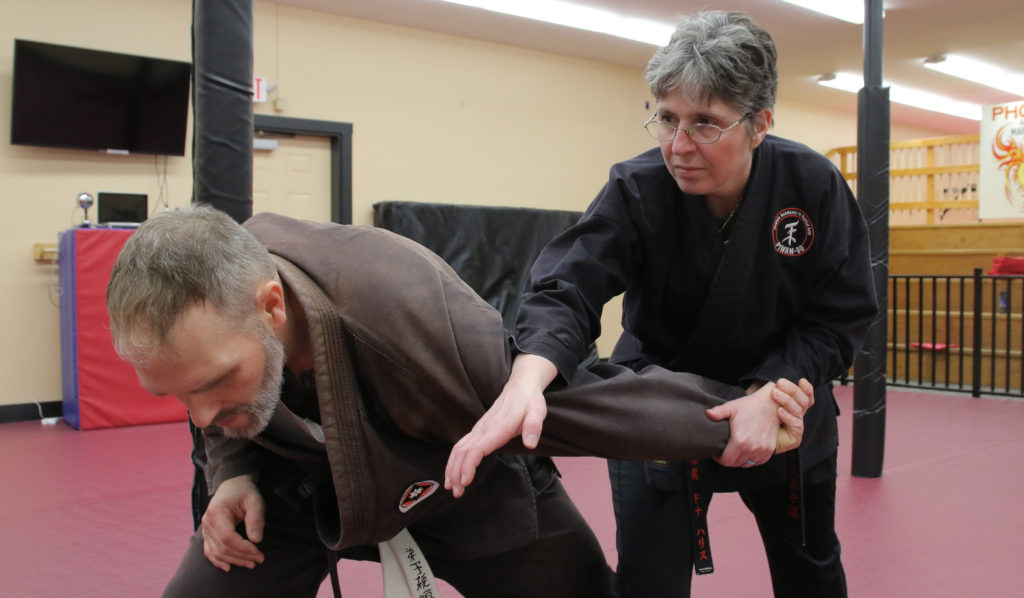
The martial art we know as karate was developed in the Ryukyu Kingdom (1429-1879) under the influence of Kung Fu, particularly the Fujian White Crane style. The kingdom was located on the Ryukyu islands and was ruled as a tributary state of imperial China before being invaded by Japan in 1609. It was dissolved in 1879 to form the present-day Okinawa Prefecture.
Gichin Funakoshi (1868-1957) was an Okinawan who brought karate to Japan in 1922 and is accepted as the father of modern karate. He changed the art’s name to mean “way of the empty hand”, and taught karate as a path to self-knowledge, not just a study of the technical aspects of fighting.
The Pinan kata are a series of five empty hand forms taught in many karate styles. A kata is a detailed choreographed pattern of martial arts movements made to be practiced alone.
While modern karate is now considered a striking art using punching, kicking, knee strikes, elbow strikes and open-hand techniques, the Harrises and their group wanted to steer students back to the philosophy of self-development. Adding the suffix “-do” (pronounced “daw”), which means “the way/path”, implies that karate-do is a total way of life that goes well beyond self-defense. Pinan-do teaches students to compete and strive to excel against themselves.
Students at Phoenix Academy range from two-year-olds to fifty-year-olds, with many families involved, Donna Harris said. “We are a very family-oriented school.”
She said she thinks the reason her school was voted Best of the Best “is based overall on people’s reflection of what we do here, and the quality of instruction that we give, and the fact that our instruction goes beyond just the martial arts. It’s more about building the entire person – helping you discover who you are, from the inside out.”
Harris said she thinks the success of the teaching at the dogo is due in part to “the variety of instructors that we have, that offer skills and a mindset that is unmeasurable.”
Sosai Mark Fryover is one of the instructors, along with the Harrises. And then “we are fortunate enough to have our own instructor (Tetsudai (“helper”) Tim Doyon) in-house who helps us to further our education,” she said. “And he is also donating his talents to help bring the next generation of students up, as well.”
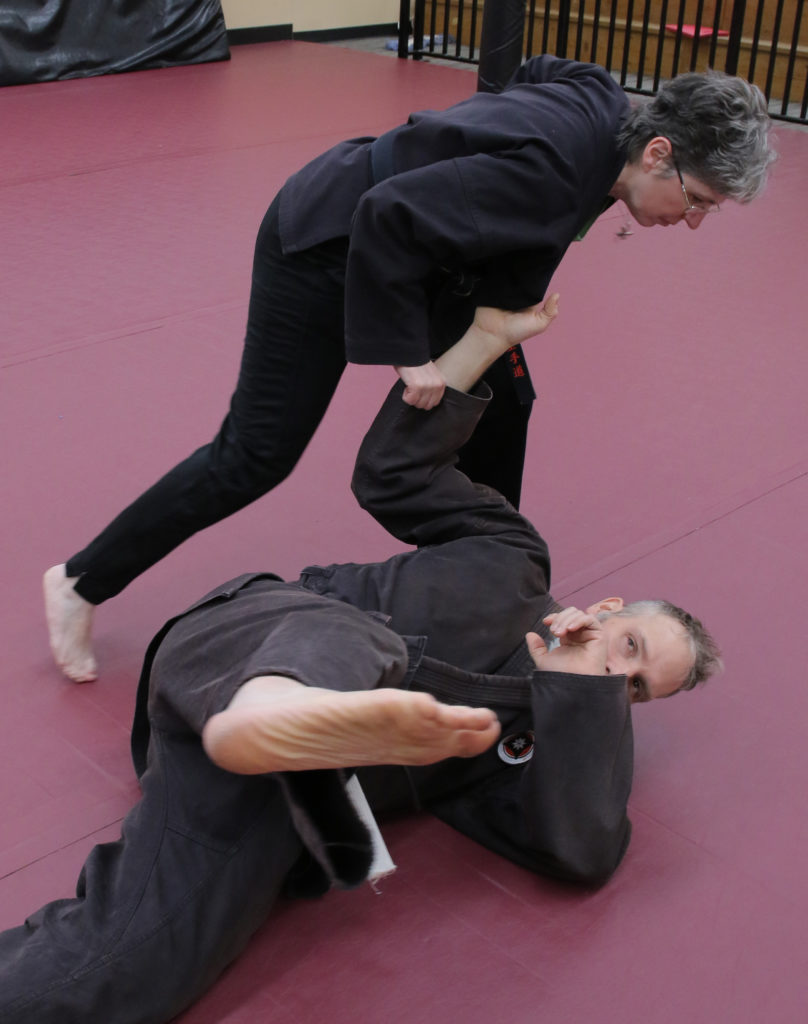
Harris said she has been a martial artist for 23 years, but never stops learning, even from new students. “I have to learn how to teach them,” she said. Harris has been learning moves, techniques and philosophy from Doyon for the past three years.
“As a martial artist, training never ends. There’s always more to learn, there’s always more to discover about the art. Martial arts is an art, and it’s not something that you just read about. It’s something that you discover more and more,” she said. “As you practice it, you discover why the katas were written the way that they were written – what defense techniques were actually anticipated in the writing of the kata.”
With the martial arts moves if the 1960s and 1970s increasing the popularity of martial arts around the world, karate was pursued by some students only for its fighting techniques. Harris’ school promotes karate as a defensive technique, with a holistic approach that teaches students to look inward to improve themselves.
Harris spent several hours training with Doyon last Friday afternoon. Constant learning is important, Doyon said, because “everything is perishable, everything fades.” To achieve a level of expertise “you have to keep up that constant level of practice all the time to be at that level.”
“My master used to always say, people often feel that when you get to a point where you feel you’re enlightened, that you’re at that place forever. But that’s not the truth,” Doyon said. “It’s just a marker on the road. Really, whatever got you to that point of enlightenment, you have to keep up that practice.”
Harris echoed that sentiment, explaining that this is why she continues to train and learn.
When asked about her level as a black belt, Harris said that in many styles of karate, “it’s all about rank. In our (Pinan-do) style, it’s not about rank. We’re really not worried so much about the rank,” but about the knowledge she and her students have about this martial art. The school is more interested in the growth of students, she said.
“So I’ve been practicing for 23 years, and therefore I have 23 years more experience than a student coming in off the street. So is that a rank? That’s what classifies me as having more experience,” than a new student, she said.
The belt system at Phoneix Academy is intended to recognize a student having learned a certain number of moves. As they memorize more moves, they move up in the belt system. But the ranking of a belt color should be “more of a personal thing,” Doyon said. Rank “isn’t something to be displayed and held above peoples’ heads.”
Harris and Doyon both emphasized that the importance of their levels of knowledge is not in achieving a title, but in being able to share their knowledge with others. “The reward is in passing on the knowledge,” Doyon said, while the title is only important in that it lets the student know what they have learned.
“And I think that is one of the reasons that we win this award year after year,” Harris said. Parents will initially come to the school with the mindset that “I want to teach my child discipline, or my kid has watched ‘Teenage Mutant Ninja Turtles’ and wants to learn karate. And then they shortly discover that it’s so much more than that.”
“They see how we’re interacting with the children. It’s not just, ‘Hey, I’m teaching you how to do pushups. I’m teaching you to be fearful of me.’ It’s more, ‘So I have something to share, and I have as much to learn from you as you do from me, and we’re here to learn together.’,” Harris said.
“There’s something to learn from everyone,” she said. With new students who are just beginning, “I can learn patience. I can learn kindness. I can learn how to interact, how to pass my knowledge on to somebody.” Every student is different, and she learns what is needed to help each of those students.
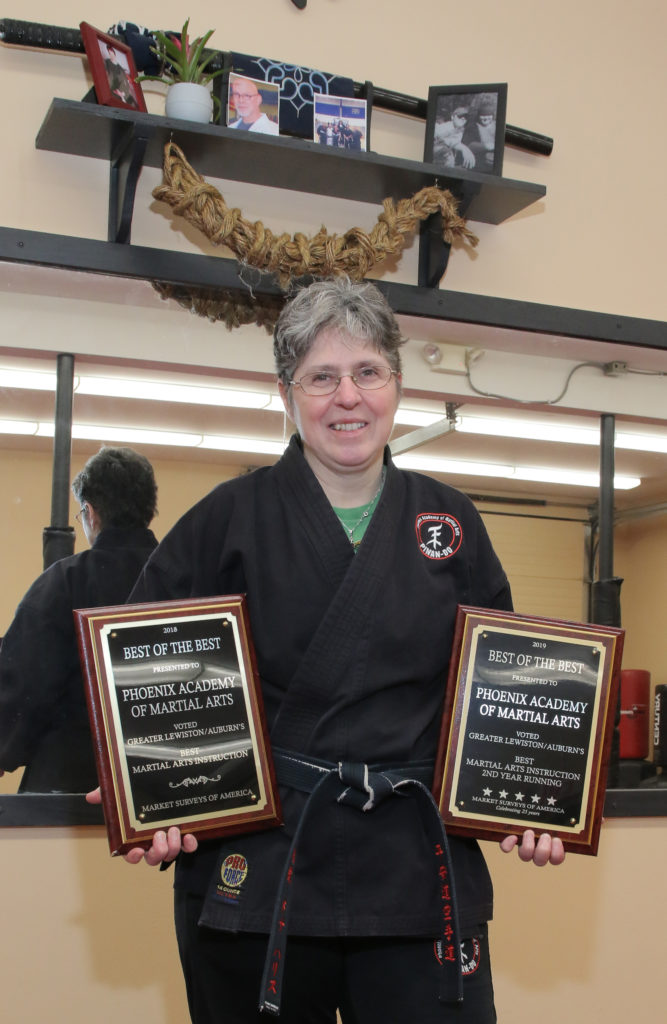
Harris said she is excited about 2021 because the school is evaluating how it teaches its students and will be changing its curriculum for a more focused approach to learning karate. “We will be evolving it to reflect what we’ve discovered. We’re actually going to be taking out a lot of the things that we have that didn’t really have the values that we want to share. And we’d rather have less material, stronger, and have our students have a complete understanding of why they’re learning what they’re learning.”
The school will look at teaching students what the (karate) moves mean, how to execute them, how to use them to defend themselves, and how to use those moves and that knowledge in their everyday life “to move forward and be a better person,” she said.
First snowstorm of winter
Out and About
By Rachel Morin
Our first snowstorm of winter started Saturday afternoon, Dec. 5, with big snowflakes melting immediately upon hitting the ground.
I watched diligently between checking off items on my To Do List. We had periodic TV announcements of an anticipated snow drop of 10 inches.

As the afternoon wore on, a wind picked up and snow started accumulating. Towards 8 p.m. or so, we lost power. Looking out my backyard window, with the aid of a flashlight, I could make out my tall scarlet flowered rhododendron bush swaying back and forth under a strong wind.
The wind increased and I went to bed and was lulled to sleep by the wind whipping around. I slept all night. Waking the next morning, I looked out the window to check on the rhododendron. Yes, it was there standing, tall and straight, as usual. And a beautiful thick carpet of white snow covered the back yard and draped the beautiful trees in the thick woods beyond.
The accumulation did fall short of the 10 inch prediction, but I don’t know the actual amount that fell.
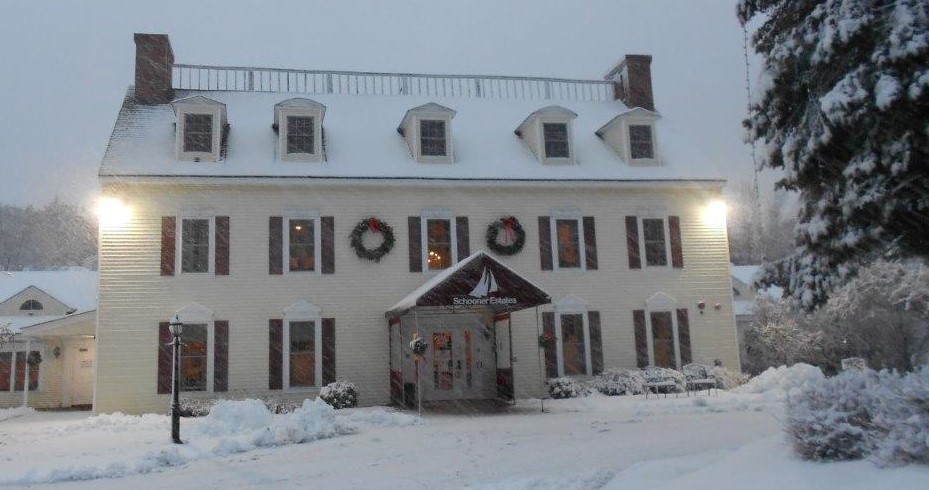
Seeing the neighbors walking by later, they advised me that the power came on at 1 am. And I thought of the dedicated CMP workers, always there in times like these, working on the lines to restore power to as many customers as possible, in numbing cold weather.
I am a Mainer and love the four seasons of Maine. My least favorite season is Winter. It starts the year in January and ends the year in December. It seems to be the longest season! My favorite season is Autumn. The fall flowers last in my garden through mid- November many times.
When December comes, I think of my favorite winter poem by Oliver Herford—
I heard a bird sing
In the dark of December.
We are nearer to spring
Than we were in September!
I like the beauty of the first snowfall and appreciate the finality of the last snowfall.
The very next day after our storm, I dressed appropriately and toured the grounds of Schooner Estates Retirement Community, camera in hand, to enjoy the beauty of the grounds, and the quietness and solitude everywhere. No one was about. The Maintenance Crew had long completed clearing away the snow from the roads and were busy inside the buildings on other chores.
A lone shoveler, Bob Lindahl, was touching up the parking lot and walkways at the Memory Care Building. He was the only person about that morning and said he took care of what needed to be done at The Memory Care Building.
I took a few more days to take more pictures and was pleased to notice the return of the wild turkeys in back of the buildings. We hadn’t seen them around in ever so long. It was like seeing old friends as they paraded out back next to the thick woods. I think you will like seeing their pictures.
I also returned at night to capture a few night scenes and the Christmas lights on campus.
